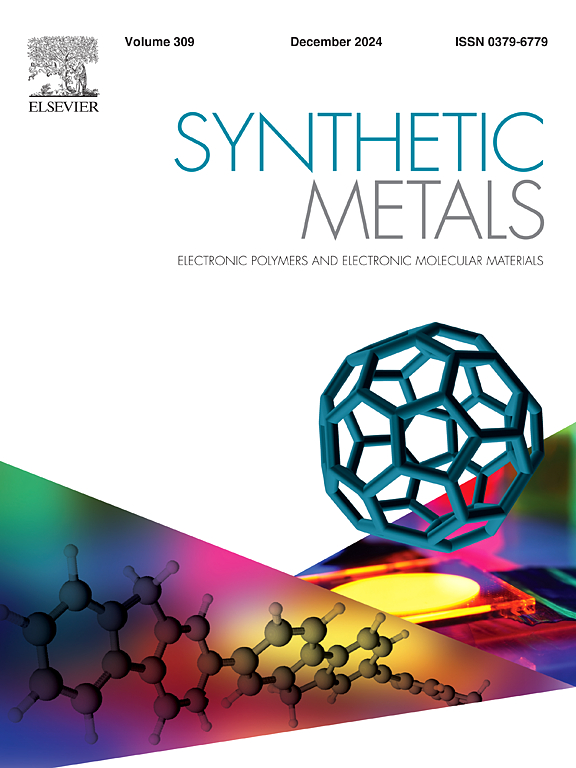两有机粒子聚吡咯复合材料的电聚合及双致动传感性能
IF 4
3区 材料科学
Q2 MATERIALS SCIENCE, MULTIDISCIPLINARY
引用次数: 0
摘要
用化学氧化聚吡咯(CP)或碳化物衍生碳(CDC)颗粒悬浮液进行恒流电聚合(EP),制备EPCP和EPCDC复合膜。除了这些颗粒外,材料还包括用于制备颗粒悬浮液的磷钨酸(PTA)阴离子和用作电解质的十二烷基苯磺酸盐(DBS-)。利用扫描电子显微镜(SEM)、能量色散x射线(EDX)和傅里叶变换红外光谱(FTIR)对复合材料进行了表征,并对其电导率和密度进行了测量。通过线性致动器在有机电解质溶液中的电化学-力学响应,量化了薄膜的双致动-传感能力。用循环伏安法和方波法研究了三种不同的电位范围。通过还原(阳离子驱动驱动)膨胀的EPCP致动器实现了2.6 %的最大应变,而通过氧化(阴离子驱动)膨胀的EPCDC显示了7.2 %的最大应变。这些值超过了文献中报道的其他阳离子或阴离子驱动的PPy复合材料。EPCP的致动电荷密度是EPCDC致动器的1.5 ~ 1.7 倍。尽管材料复杂性很高,但仍实现了双驱动和同步驱动传感能力的提高。在所研究的电位范围内,两个致动器都在电荷平衡下工作,这一点通过库安响应得到了证明。未来的研究将探索执行器耐久性和电荷存储容量的预期提高。本文章由计算机程序翻译,如有差异,请以英文原文为准。
Electropolymerization and dual actuating-sensing capabilities of polypyrrole composites with two organic particles
Polypyrrole film composites were galvanostatically electropolymerized (EP) from suspensions of either chemically oxidized polypyrrole (CP) or carbide-derived carbon (CDC) particles, generating EPCP and EPCDC composite films. In addition to these particles the material includes anions of phosphotungstide acid (PTA), used to prepare the particle suspensions and dodecylbenzenesulfonate (DBS-) used as electrolyte. The final composite materials were characterized using scanning electron microscopy (SEM), energy dispersive X-ray (EDX) analysis and Fourier transform infrared (FTIR) spectroscopy, with their conductivity and density also measured. The dual actuating-sensing capabilities of the of the films (linear actuators) were quantified from their electrochemomechanical responses in organic electrolyte solution. Three different potential ranges were explored by cyclic voltammetry and square potential waves. The EPCP actuator, which expands upon reduction (cation-driven actuation) achieves a maximum strain of 2.6 %, while the EPCDC, which expands by oxidation (anion-driven) showed a maximum strain of 7.2 %. These values surpass those reported in the literature for other cation- or anion-driven PPy composites. The EPCP´s actuating charge density was 1.5–1.7 times higher than that of the EPCDC actuators. Despite the high material complexity improving dual and simultaneous actuating-sensing capabilities were achieved. In the studied potential ranges, both actuators work under charge balance, as proved by the coulovoltammetric responses. Future studies will explore the expected increase in actuator durability and charge storage capacity.
求助全文
通过发布文献求助,成功后即可免费获取论文全文。
去求助
来源期刊

Synthetic Metals
工程技术-材料科学:综合
CiteScore
8.30
自引率
4.50%
发文量
189
审稿时长
33 days
期刊介绍:
This journal is an international medium for the rapid publication of original research papers, short communications and subject reviews dealing with research on and applications of electronic polymers and electronic molecular materials including novel carbon architectures. These functional materials have the properties of metals, semiconductors or magnets and are distinguishable from elemental and alloy/binary metals, semiconductors and magnets.
 求助内容:
求助内容: 应助结果提醒方式:
应助结果提醒方式:


